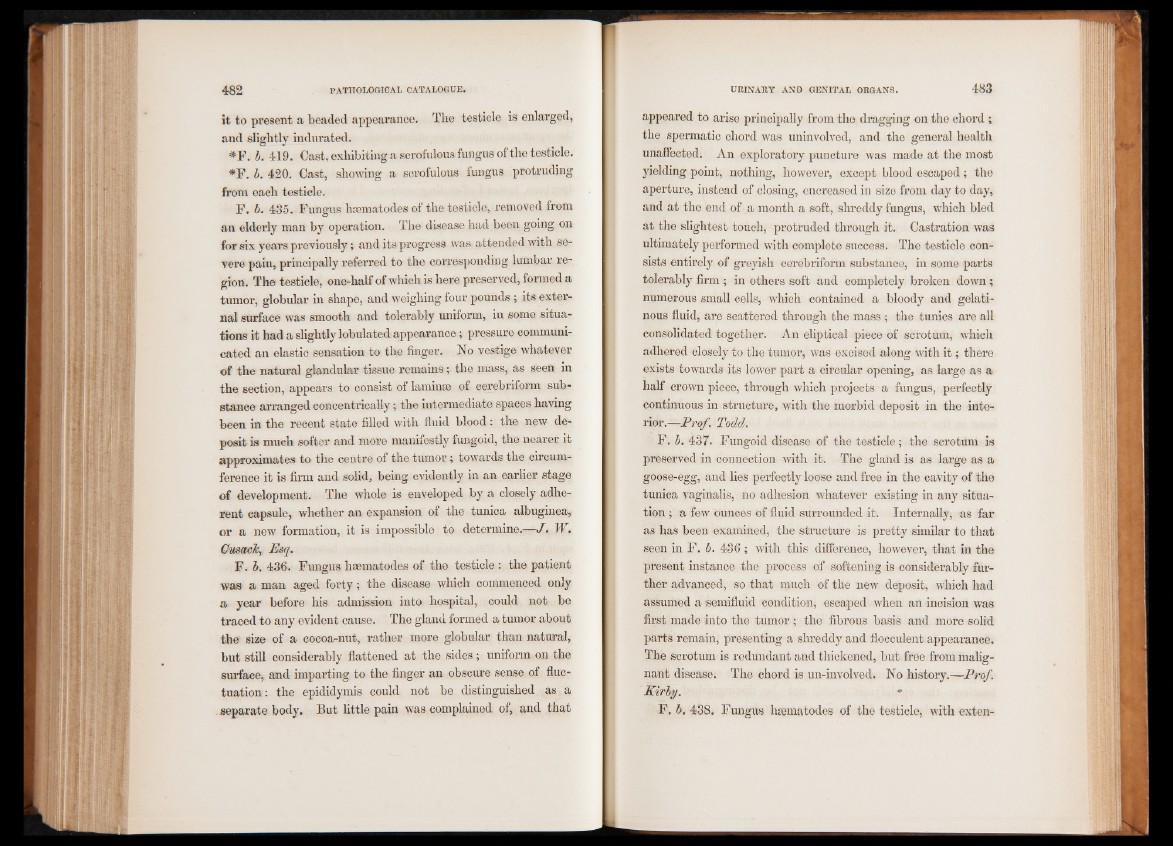
it to present a beaded appearance. The testicle is enlarged,
and slightly indurated.
*F. b. 419. Oast, exhibiting a scrofulous fungus of the testicle.
*F. b. 420. Oast, showing a scrofulous fungus protruding
from each testicle.
F. b. 435. Fungus haematodes of the testicle, removed from
an elderly man by operation. The disease had been going on
for six years previously; and its progress was attended with severe
pain, principally referred to the corresponding lumbar region.
The testicle, one-half of which is here preserved, formed a
tumor, globular in shape, and weighing four pounds ; its external
surface was smooth and tolerably uniform, in some situations
it had a slightly lobulated appearance; pressure communicated
an elastic sensation to the finger. No vestige whatever
of the natural glandular tissue remains ; the mass, as seen in
the section, appears to consist of laminae of cerebriform substance
arranged concentrically; the intermediate spaces having
been in the recent state filled with fluid blood: the new deposit
is mueh softer and more manifestly fungoid, the nearer it
approximates to the centre of the tumor; towards the circumference
it is firm and solid, being evidently in an earlier stage
of development. The whole is enveloped by a closely adherent
capsule, whether an expansion of the tunica albuginea,,
or a new formation, it is impossible to determine.—J . W.
Cusack, Esq.
F. b. 436. Fungus haematodes of the testicle : the patient
was a man aged forty; the disease which commenced only
a year before his admission into hospital, could not be
traced to any evident cause. The gland formed a tumor about
the size of a cocoa-nut, rather more globular than natural,
but still considerably flattened at the sides; uniform on the
surface, and imparting to the finger an obscure sense of fluctuation
: the epididymis could not be distinguished as a
separate body. But little pain was complained of, and that
appeared to arise principally from the dragging on the chord ;
the spermatic chord was uninvolved, and the general health
unaffected. An exploratory puncture was made at the most
yielding point, nothing, however, except blood escaped; the
aperture, instead of closing, encreased in size from day to day,
and at the end of a month a soft, shreddy fungus, which bled
at the slightest touch, protruded through it. Castration was
ultimately performed with complete success. The testicle consists
entirely of greyish cerebriform substance, in some parts
tolerably firm ; in others soft and completely broken down ;
numerous small cells, which contained a bloody and gelatinous
fluid, are scattered through the mass ; the tunics are all
consolidated together. An eliptical piece of scrotum, which
adhered closely to the tumor, was excised along with it ; there
exists towards its lower part a circular opening, as large as a
half crown piece, through which projects a fungus, perfectly
continuous in structure, with the morbid deposit in the interior.—
Prof. Todd.
F. b. 437. Fungoid disease of the testicle; the scrotum is
preserved in connection with it. The gland is as large as a
goose-egg, and lies perfectly loose and free in the cavity of the
tunica vaginalis, no adhesion whatever existing in any situation
; a few ounces of fluid surrounded it. Internally; as far
as has been examined, the structure is pretty similar to that
seen in F. b. 436 ; with this difference, however, that in the
present instance the process of softening is considerably further
advanced, so that much of the new deposit, which had
assumed a semifluid condition, escaped when an incision was
first made into the tumor; the fibrous basis and more solid
parts remain, presenting a shreddy and flocculent appearance.
The scrotum is redundant and thickened, but free from malignant
disease. The chord is un-involved. No history.—Prof.
Kirby. *
F. b. 438. Fungus haematodes of the testicle, with exten